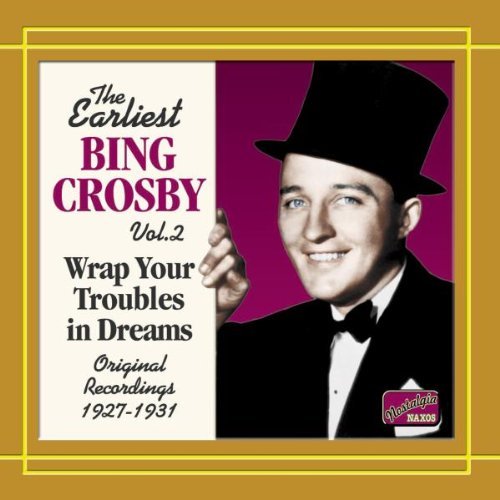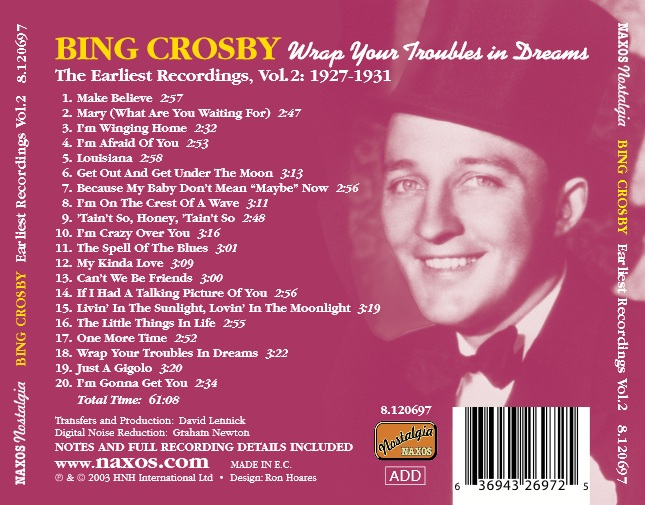Logowanie
Mikołaj - ten to ma gest!
Elton John, The Mamas & The Papas, Cat Stevens, Rod Stewart, Bobbie Gentry, Stevie Wonder, Engelbert Humperdinck
Memory Lane
Edycja Numerowana - 1000 egzemplarzy w skali światowej
RACHMANINOV, Eiji Oue, Minnesota Orchestra
Symphonic Dances / Vocalise
Best Recordings of 2001!!! NAJCZĘŚCIEJ KUPOWANA PŁYTA Z RR!
Karnawał czas zacząć!
Music of Love - Hi-Fi Latin Rhythms
Samba : Music of Celebration
AUDIOPHILE 24BIT RECORDING AND MASTERING
CHOPIN, LISZT, DEBUSSY, DVORAK, Gerhard Oppitz
Dances romantiques - A fantastic Notturno
Wzorcowa jakość audiofilska z Clearaudio
Winylowy niezbędnik
ClearAudio
Double Matrix Professional - Sonic
najbardziej inteligentna i skuteczna pralka do płyt winylowych wszelkiego typu - całkowicie automatyczna
Bing Crosby
The Earliest Bing Crosby Vol. 2 - Wrap Your Troubles in Dreams

- Bing Crosby - vocal
"BING CROSBY Wrap Your Troubles In Dreams The Earliest Recordings, Vol.2: 1927-1931 This second volume of Bing Crosby: The Earliest Years dovetails snugly with its predecessor. It will undoubtedly broaden the contemporary listener’s appreciation of the developing Crosby talent as he moved ahead of his Rhythm Boys partners on the road to fame. That road was filled with changes and changing musical influences. When Crosby made his first recordings, the major influence was Al Jolson. You can especially hear the results of that idolatry in the earliest of these tracks. At various points, Crosby aims for that controlled, fluttery spin Jolson would put on certain notes. He even tries some of the off-the-cuff ad libbing and plays with or even parodies the lyrics, a la Jolson. With these recordings arranged chronologically on this collection, you can also hear the Jolson influence diminishing. Part of the reason was that he was coming into contact with other musicians. What emerged was a melding of these different forces into Crosby’s own distinctive sound and technique. Crosby often said Louis Armstrong was the next and perhaps even greater influence on his singing. He first saw him perform shortly after he and partner Al Rinker joined Paul Whiteman’s Orchestra in Chicago. He was entranced by Armstrong’s growl when he sang, his unique scat choruses and, above all, the combination of rhythm, humour and simplicity he gave to a song. Some of the bounce you can hear coming into the recordings as time passes is clearly due to Armstrong’s influence. Joining Whiteman brought with it bonuses well beyond the pay, public exposure and promotion. It brought musical education. It was here that Crosby truly learned to be a singer who could take command of a song and an audience — even if he never thought he had the same electrifying abilities on the stage or in the recording studio as Jolson or Armstrong — and have fun with it. Whiteman remains one of those musicians whose talent was not so much what he did as what he enabled others to do. Called the King of Jazz, he wasn’t even a jazz musician. But he employed others who were and, consequently, he had one of the best musical organizations of the 1920s and early ’30s, populated by a string of musicians who would go on to great things on their own or as part of later orchestras. Among the greatest influences from those Whiteman years were violinists Matty Malneck and Joe Venuti, guitarist Eddie Lang, arrangers Bill Challis and Lennie Hayton, and cornetist Bix Beiderbecke, to mention only a few. Through his work with them, Crosby’s musical knowledge and taste grew. And these musicians saw something in him that they didn’t in Rinker or the third member of the Rhythm Boys, Harry Barris. They liked both Rinker and Barris personally, but they really took to Crosby, encouraging and shaping him musically. Challis was later to say he was given a free hand in structuring the arrangements and he threw solos to Crosby often because he was so good. Crosby was eventually to prove a shrewd showman and businessman, but as he readily admitted in later years, timing and luck played large roles in his popularity, especially in his younger days. One stroke of luck derived from the often-maddening way he and his partners paid more attention to having fun than making music. As a result, Whiteman decided to send them out on their own as a vaudeville act in 1928. He also allowed Crosby to record some sides on his own. It was a blessing, giving Crosby greater exposure as the main feature within the act and on wax. When the Rhythm Boys finally split from Whiteman, the timing was right. The era of crooners such as Rudy Vallee arrived and Bing was ultimately able to become the most virile-sounding member of this group. As well, Whiteman had peaked and would begin a long decline. Even the Rhythm Boys wouldn’t withstand all this change and the mounting tensions between the three performers. Crosby was on the rise, coming into his own as a featured vocalist who needed no back up or support. His work with Gus Arnheim proves that. The recordings in this Naxos collection tell this story much better than words can. You can hear the emerging Crosby confidence and ability, the strengthening of the voice and the adoption of the vocal mannerisms that would make him the world’s most consistently popular singer from the early 1930s through to the 1950s. And you can hear how much fun he was having as those early years rolled on. The results are still exciting. There are some fascinating sides included in this collection. One of the most technically and anecdotally interesting is ’Tain’t So, Honey, ’Tain’t So. It opens cold on Crosby’s vocal, with no instrumental intro. This was highly unusual in 1928 and many collectors long suspected the master had been redubbed with the intro removed. It was, in fact, recorded just the way it was issued. But not without some problems in the studio. Without an introductory chord, Crosby kept missing his note until Challis got a dime store pitch pipe to get him on key. That and Beiderbecke repeatedly fluffing his solo led to a need for nine takes before they got it right. Because My Baby Don’t Mean "Maybe" Now is one of the bounciest of the early recordings. Crosby was obviously becoming secure enough to just go with the arrangement and the band. And some of the characteristic Crosbyisms are there, especially the bu-bu-bu-boos. My Kinda Love marked Crosby’s first recording under his own name, backed by Whiteman sidemen Matty Malneck, Roy Bargy and Snoozer Quinn. The song became part of Crosby’s early standard repertoire. He’s in even better voice on If I Had a Talking Picture of You, on which he is aided by a superb Lennie Hayton arrangement. Perhaps the best of the sides on this collection are those with Gus Arnheim’s Orchestra. His 2March 1931 session yielded a classic: Wrap Your Troubles in Dreams. The song would forever be identified with Crosby and he re-recorded it in later years. This version is perfectly laced with many of the signature touches that will always mean Crosby to his fans. The final track is his final side with Arnheim: I’m Gonna Get You. From here on, Crosby would not be an artist working with a name band; he would be a name artist with a band working with him. The singer who would very much set the pace of American popular music for the next two decades had arrived. And that’s an apt place for this collection to end. Greg Gormick, March 2003, Toronto, Ontario Original monochrome photo of Bing Crosby from Michael Ochs Archives / Redferns"





























